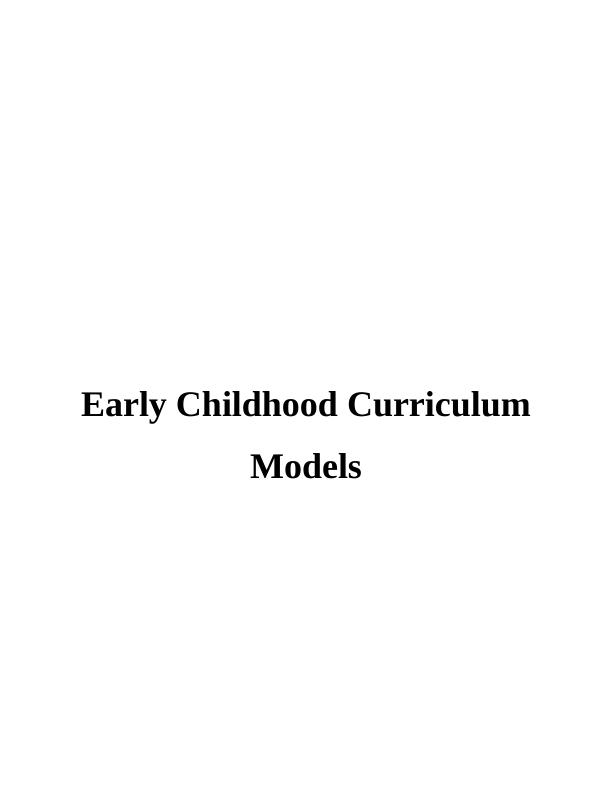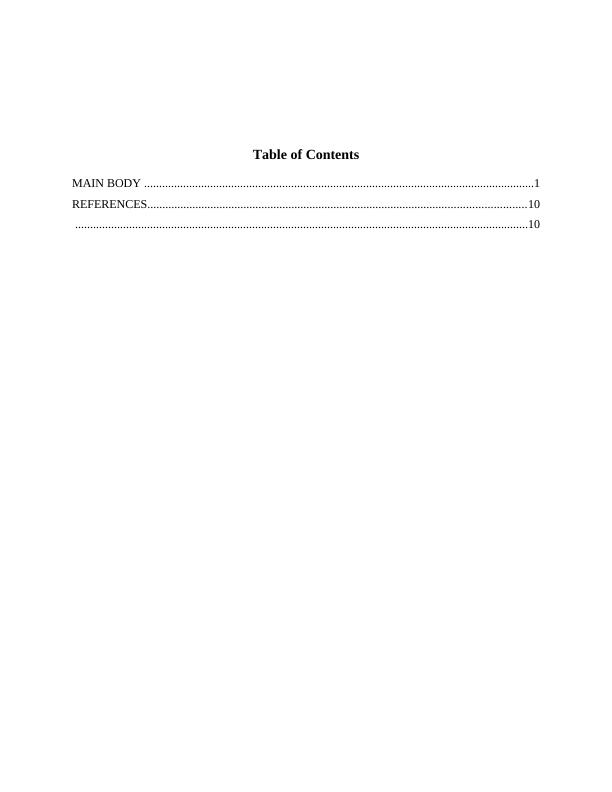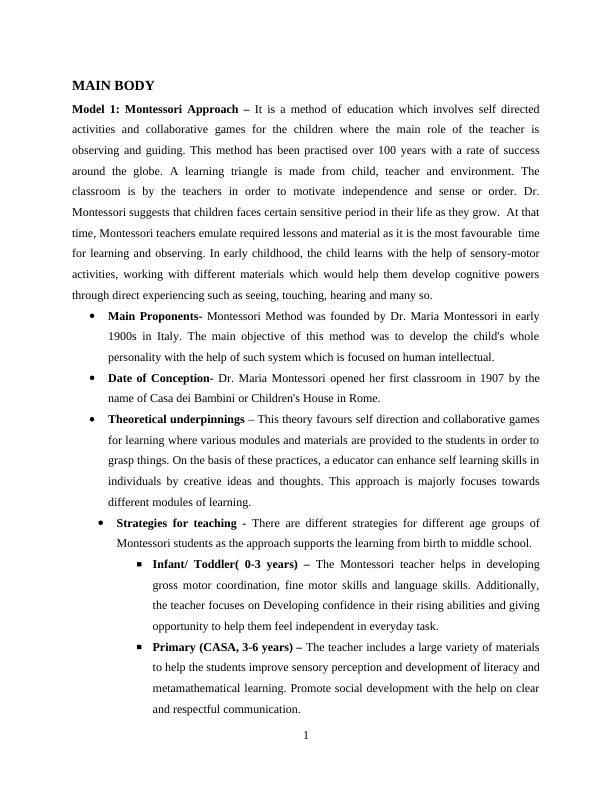Ask a question from expert
Early Childhood Curriculum Models
12 Pages3709 Words110 Views
Added on 2020-10-22
Early Childhood Curriculum Models
Added on 2020-10-22
BookmarkShareRelated Documents
Early Childhood CurriculumModels

Table of ContentsMAIN BODY ..................................................................................................................................1REFERENCES..............................................................................................................................10.......................................................................................................................................................10

MAIN BODY Model 1: Montessori Approach – It is a method of education which involves self directedactivities and collaborative games for the children where the main role of the teacher isobserving and guiding. This method has been practised over 100 years with a rate of successaround the globe. A learning triangle is made from child, teacher and environment. Theclassroom is by the teachers in order to motivate independence and sense or order. Dr.Montessori suggests that children faces certain sensitive period in their life as they grow. At thattime, Montessori teachers emulate required lessons and material as it is the most favourable timefor learning and observing. In early childhood, the child learns with the help of sensory-motoractivities, working with different materials which would help them develop cognitive powersthrough direct experiencing such as seeing, touching, hearing and many so. Main Proponents- Montessori Method was founded by Dr. Maria Montessori in early1900s in Italy. The main objective of this method was to develop the child's wholepersonality with the help of such system which is focused on human intellectual. Date of Conception- Dr. Maria Montessori opened her first classroom in 1907 by thename of Casa dei Bambini or Children's House in Rome. Theoretical underpinnings – This theory favours self direction and collaborative gamesfor learning where various modules and materials are provided to the students in order tograsp things. On the basis of these practices, a educator can enhance self learning skills inindividuals by creative ideas and thoughts. This approach is majorly focuses towardsdifferent modules of learning. Strategies for teaching - There are different strategies for different age groups ofMontessori students as the approach supports the learning from birth to middle school. ▪Infant/ Toddler( 0-3 years) – The Montessori teacher helps in developinggross motor coordination, fine motor skills and language skills. Additionally,the teacher focuses on Developing confidence in their rising abilities and givingopportunity to help them feel independent in everyday task.▪Primary (CASA, 3-6 years) – The teacher includes a large variety of materialsto help the students improve sensory perception and development of literacy andmetamathematical learning. Promote social development with the help on clearand respectful communication.1

Learning – Montessori approach uses various methods and materials to help thechildren of different age learn in an easier yet creative way. Some of the learningmaterials are movable Alphabets, Pink tower, Sound Cylinders, puzzel maps and manymore. Also, this approach believes in involving students in various tasks such aspouring and scooping, Ironing, Gluing paper and many so. Assessment – This method is specifically non competitive which also believes inavoiding punishments in order to encourage confidence and development of thechildren. Primary students are responsible for their own progress through work journalwhich is updated everyday. Also individual conferences takes place with their teacherswhere they maintain portfolios of complete work.Planning and Reflection – Montessori approach requires proper planning as to decidewhat module and material would be appropriate for different age group. As thisapproach works on each student individually and mentions that each student have adifferent sensitive time to grasp things. Therefore, depending on the student'sperformance, the level of difficulty needs to be decided.Goals and outcomes- The prime Goal of Montessori method of teaching is to provide astimulated and well planned environment which will help the child in creating a perfectfoundation for creative learning. This approach also helps in developing a healthy andpositive attitude towards further schooling. Each new learning module is developed onthe basis of previous learned module which helps the child to develop self confidence.The approach works towards effective learning via making the children listen carefullyand respond to what is demonstrated or said. This makes the Montessori studentsobserve more carefully which leads to increase in their concentration abilities.Additionally, when the child is surrounded by appealing materials and learningactivities, he becomes habitual in engaging on his own which results is developing ahabit of initiation in the child.Position on play- The games or play in the respective theory are mostly self chosen,directed by themselves where the child is free to quit anytime. It involves active, alert andstress free frame of mind.2

End of preview
Want to access all the pages? Upload your documents or become a member.
Related Documents
Key Theoretical Strategies of the Montessori Method of Education- Project Reportlg...
|8
|1400
|419
Career Development And Systems Theory - PDFlg...
|8
|2101
|77
Early Childhood Learninglg...
|6
|1155
|94
Early Childhood Development Assignment Reportlg...
|8
|2181
|47
Montessori Education: Early Childhood Educational Approachlg...
|9
|1614
|68
Montessori Vision and Valueslg...
|11
|3531
|27